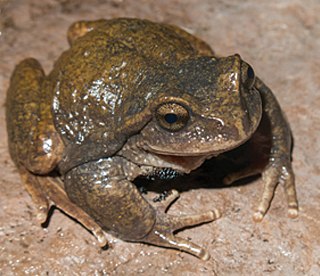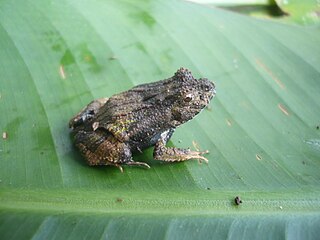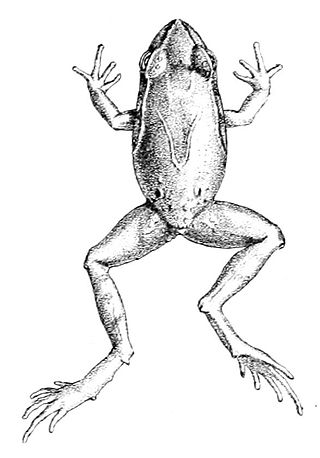
The glass frogs belong to the amphibian family Centrolenidae. While the general background coloration of most glass frogs is primarily lime green, the abdominal skin of some members of this family is transparent and translucent, giving the glass frog its common name. The internal viscera, including the heart, liver, and gastrointestinal tract, are visible through the skin. When active their blood makes them visible; when sleeping most of the blood is concealed in the liver, hiding them. Glass frogs are arboreal, living mainly in trees, and only come out for mating season. Their transparency conceals them very effectively when sleeping on a green leaf, as they habitually do.

Alsodes is a genus of alsodid frogs found in Chile and Argentina. It is the most species-rich frog genus in Patagonia. Common name spiny-chest frogs has been coined for them.

The strawberry poison frog, strawberry poison-dart frog or blue jeans poison frog is a species of small poison dart frog found in Central America. It is common throughout its range, which extends from eastern central Nicaragua through Costa Rica and northwestern Panamá. The species is often found in humid lowlands and premontane forest, but large populations are also found in disturbed areas such as plantations. The strawberry poison frog is perhaps most famous for its widespread variation in coloration, comprising approximately 15–30 color morphs, most of which are presumed to be true-breeding. O. pumilio, while not the most poisonous of the dendrobatids, is the most toxic member of its genus.

Alsodes gargola, with the common name Tonchek spiny-chest frog, is a species of frog in the family Alsodidae. It is endemic to Argentina, where it occurs in northern Patagonia.

Alsodes hugoi is a species of frogs in the family Alsodidae. It is endemic to Chile and only known from its type locality, Río Lircay, in Alto de Vilches, Talca Province, on the western slopes of the Andes. The specific name hugoi honors Professor Hugo Campos Cereceda, for his "remarkable contributions to the development of the natural sciences in Chile".
Alsodes igneus is a species of frogs in the family Alsodidae endemic to Chile; it is only known from its type locality, Tolhuaca National Park, Malleco Province, on the western slopes of the Andes. The specific name igneus, meaning "something that is of fire", was chosen to symbolize the survival of the population from a great forest fire that affected the type locality in 2000.
Alsodes kaweshkari is a species of frog in the family Alsodidae. This rare species is endemic to southern Chile where it is known from two specimens, the holotype that was collected from Puerto Edén, and one paratype from Seno Huemules on the mainland.

Alsodes vanzolinii is a species of frog in the family Alsodidae.
Chaltenobatrachus is a monotypic genus of frogs in the family Batrachylidae. The sole species, Chaltenobatrachus grandisonae, used to be included Atelognathus, which is considered the sister taxon of Chaltenobatrachus.

Edalorhina perezi is a species of frog in the family Leptodactylidae. It is one of the only two species in the genus Edalorhina in the family Leptodactylidae. This species is diurnal and terrestrial. During mating season both female and male frogs gather around treefall pools. It is found in Brazil, Colombia, Ecuador, and Peru, and possibly Bolivia. Its natural habitats are subtropical or tropical moist lowland forests, subtropical or tropical moist montane forests, and freshwater marshes. The species listed as least concern on the IUCN Red List and the population is stable.

Eupsophus calcaratus is a species of frog in the family Alsodidae. It is endemic to Patagonia. It has one of the broadest distributions of any Chilean frog.
Eupsophus contulmoensis is a species of frog in the family Alsodidae. It is endemic to Chile. Its natural habitats are temperate forest and intermittent freshwater marshes. It is threatened by habitat loss and rainforest deforestation.

Eupsophus emiliopugini is a species of frog in the family Alsodidae. It is found in the temperate Nothofagus forests of Chile between 40°50'S and 45°20'S, and in the Lago Puelo National Park, Chubut Province, Argentina. The specific name emiliopugini honors Professor Emilio Pugín, for "his contribution to knowledge of the reproductive biology and development of the Chilean frogs". Common name Emilio's ground frog has been coined for the species.

Eupsophus migueli is a species of frog in the family Alsodidae. It is endemic to Chile. Its natural habitats are temperate forest and intermittent freshwater marshes. It is threatened by habitat loss.
Leptodactylus pustulatus is a species of frog in the family Leptodactylidae. It is endemic to Brazil. Its natural habitats are moist savanna, subtropical or tropical moist shrubland, freshwater marshes, pastureland, rural gardens, urban areas, and ponds. The female frog seems to provide some level of parental care for the tadpoles. This is a common species of frog and the International Union for Conservation of Nature has listed it as being of "least concern".

Lithodytes is a genus of frogs in the family of Leptodactylidae. It is monotypic, being represented by the single species, Lithodytes lineatus, also commonly known as the gold-striped frog or painted antnest frog. It is found in tropical South America where it lives in humid forests among the leaf litter. These frogs build foam nests at the edge of temporary pools, and the tadpoles develop within these. The frogs also associate with certain leafcutter ants and breed inside their nests without being attacked by the ants.
Telmatobius dankoi, also known as the Loa water frog, is a species of critically endangered aquatic frog in the family Telmatobiidae. It is endemic to Chile and is only known from its type locality near Calama, in the El Loa province. Only 14 individuals are known from captivity following the destruction of its habitat prior to 2019, so it may already be extinct in the wild. However, it is doubtfully distinct from Telmatobius halli and thus may not be a distinct species.

Thoropa is a genus of frogs in the family Cycloramphidae. They are endemic to eastern and southeastern Brazil. They are sometimes known as river frogs.

Engystomops is a genus of frogs in the family Leptodactylidae. They are known commonly as foam frogs or túngara frogs, though the latter name most commonly refers to Engystomops pustulosus. They are native to the Americas from southern Mexico south to the Amazon Basin.

The Alsodidae are a small family of frogs from South America between Patagonia and southern Brazil. It contains 30 species in three genera. This family, along with several other families, used to be included in the family Leptodactylidae. It was then a subfamily in the family Cycloramphidae, before being recognized as a family first in 2011.













